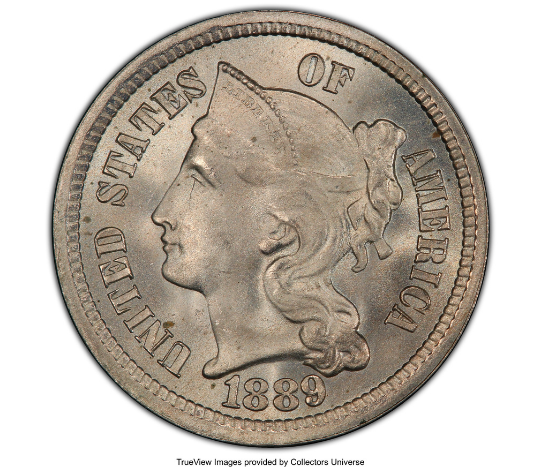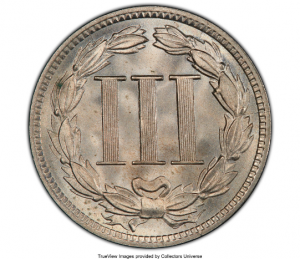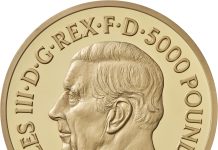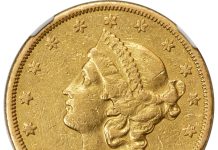
The Professional Coin Grading Service (PCGS) Coin of the Month is the 1889 Three Cent Nickel.
The three-cent nickel isn’t one of the more widely known coins around, and there are certainly plenty of non-collectors who have simply never even heard about these unusual 19th-century coins. Yet, among those who focus on the genre of so-called odd denomination U.S. coinage, the love is strong. Three-cent coins were first issued in the United States in 1851 to more easily facilitate the purchase of first-class United States postage stamps, which cost three cents at that time.
Originally issued in silver, the three-cent coinage was converted to a nickel format in 1865, and this type continued until 1889. Both types of three-cent coinage were designed by James Longacre, whose name is familiar with collectors of Indian cents, two-cent pieces, Indian Princess $3 gold coinage, and many other 19th-century pieces created by the United States chief engraver.

The 1889 three-cent nickel is considerably scarce, with only 18,125 business strikes for the last year of the series. Even in the well-worn circulated grade of Good-4, the 1889 three-cent nickel commands around $75. Prices climb from there, with uncirculated specimens regularly trading in the mid-hundreds or higher. Gem specimens are especially tough, and only small handfuls have been graded in the upper Mint State echelons. For example, consider those in the resplendent grade of MS66+, where one of just four graded at that level by Professional Coin Grading Service took $1,080 in an October 2020 Heritage Auctions event.
Coin Grading
Grade refers to a coin’s level of preservation: how many nicks or scratches or other imperfections it has. Coins are graded on a scale of one to 70, with higher numbers signifying higher grades. One represents a coin that is so well worn that it’s barely identifiable as to its type. 70 represents a perfect coin: a coin that when viewed under a five-power magnifying glass has no visible imperfections.
60 through 70 represent the Mint State (MS) grades. A coin graded MS-60 can have so many nicks and scratches and flaws that it might look as if Godzilla used it as a teething ring. MS-65 is the industry standard for “Gem.” MS-66 through MS-69 are the near-flawless super-grade or wonder coin assignations. With each grade level above MS-66, the value might double or triple.
Grade names are used in addition to numerical grades. In ascending order, these word grades are About or Almost Good; Good; Very Good; Fine; Very Fine; Extra or Extremely Fine; About or Almost Uncirculated; and Mint State.
A Proof is not a special Mint State coin. Proof refers to a method of manufacture, not a grade. Although Proof coins are struck using specially polished dies and specially selected planchets (metal discs) to assure a chromium-like brilliance, they can circulate or be spent. Proofs are also graded on the one through 70 scale. A Proof coin grading less than Proof-60 is referred to as an “impaired Proof.”
*Images courtesy of Heritage Auctions, www.HA.com.















